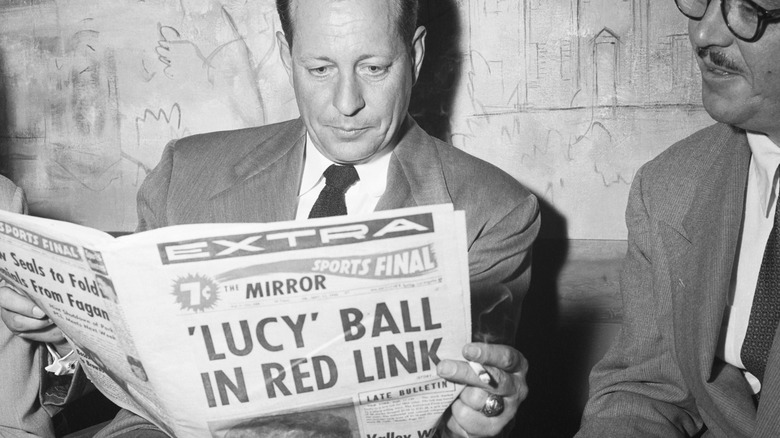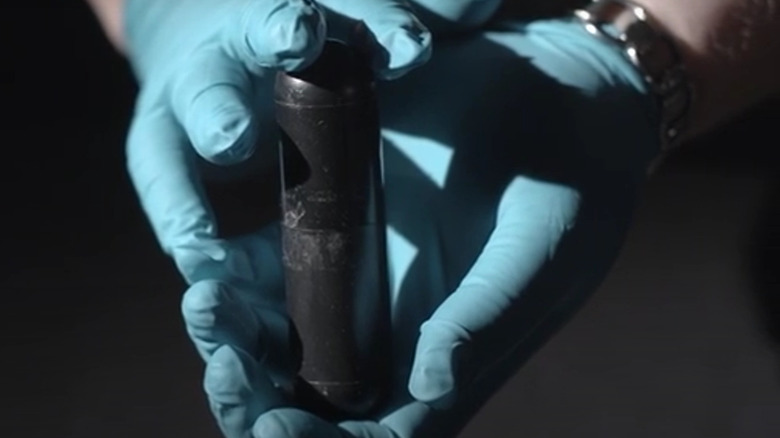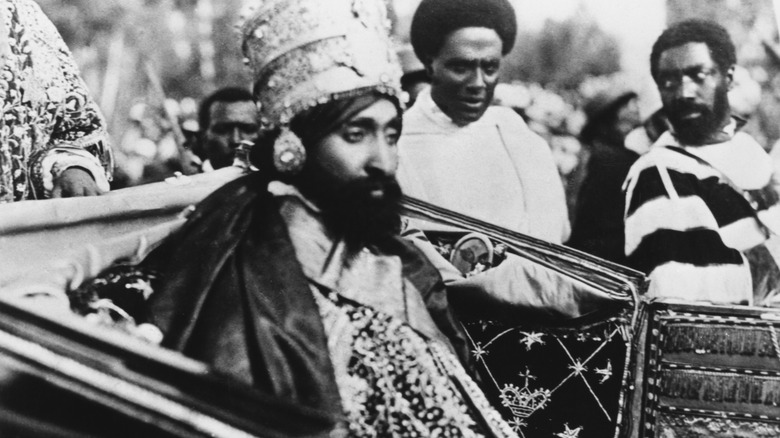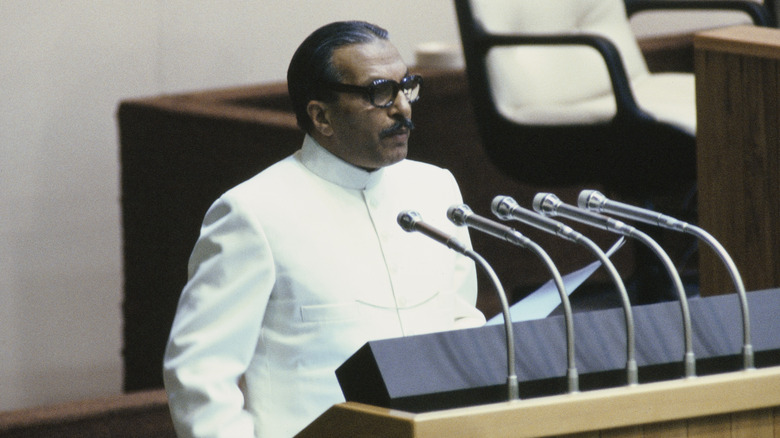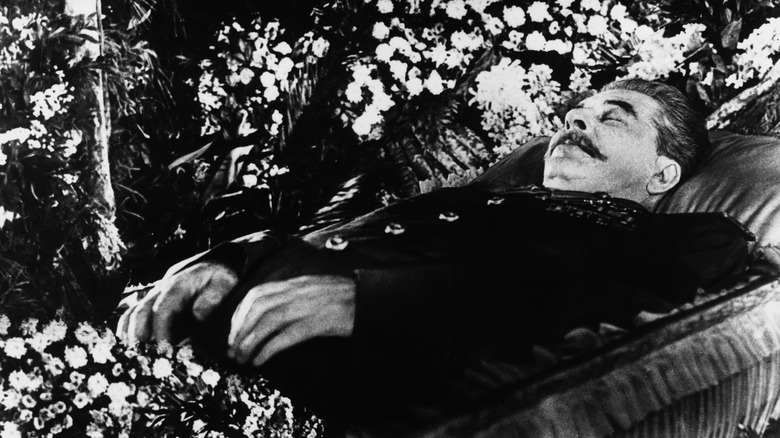Bizarre Cold War Stories You've Never Heard
It would have been nice for the world to take a few years off fighting after World War II, but there were plenty of unresolved issues even after Germany and Japan were defeated. Independence movements percolated in European-held colonies across Africa and Asia, and China went back to fighting its civil war now that Japanese involvement was zeroed out. And in Europe, the Western Allies glared warily at the Soviet Union across occupied and divided Germany and Austria.
The Soviet Union imploded in 1991, and you'll notice that U.S.-Russian relations today are far from cuddly. But before the collapse, tensions remained at least somewhat high between the Western capitalist and social-democratic countries, headed by the United States, and the communist countries, headed by the Soviet Union with China as an important featured player. The Cold War saw the two blocs of countries locked in a high-stakes chess match that played out across much of the world, with both sides notching victories, committing atrocities, and occasionally bumbling away an advantage. Here are some of the wildest stories from that era of spycraft and paranoia.
DMZ Axe Murders
"DMZ" stands for "demilitarized zone," and in the context of the inter-Korean border, it's a technically accurate name. With that said, there is an awful lot of militarization immediately outside the neutral territory in case the frozen conflict thaws again. Notably, a tree nearly resulted in a second Korean War in August 1976, when North Korean soldiers murdered two American servicemen with axes.
Tensions were already high between North Korea and the United States in the mid-1970s, with the former flexing its muscles and trying to exercise veto power over American operations nearby. On August 18, the DPRK got a chance when a handful of American and South Korean troops went into the DMZ to trim a poplar tree that was interfering with sight lines — something they apparently did regularly. North Korean troops brandishing weapons of opportunity like crowbars and axes swarmed the tree crew, wounding eight men and killing American soldiers Arthur Bonifas and Mark Barrett.
Intelligence collected around the time of the attack indicated that the North Koreans had planned to harm Americans or South Koreans in the hope that casualties would, somehow, influence the U.S. public against the continued military presence on the peninsula. The Americans and South Koreans instead sent an armed strike force into the DMZ to cut down the tree altogether, coinciding with a military flyover of North Korean sites. Today, the incident remains a mere chapter in the bizarre story of North Korea.
Operations Silver and Gold
After the shooting stopped in World War II, Europe was generally divided between Soviet and Western spheres of influence according to who had liberated what. The most notable exceptions were two big prizes — Vienna and Berlin, which were jointly occupied by American, British, French, and Soviet troops. (Vienna would be handed back to Austria in 1955; Berlin famously stayed divided longer.) As these two cities hosted Western and Soviet forces cheek by jowl, they provided great opportunities for a little eavesdropping.
British forces in Vienna had the idea first. When they realized the Soviets were using Austrian phone lines to confer with Moscow, they bought a building and dug a tunnel from the basement to tap into the phone lines surreptitiously. Running from 1948 to 1952, Operation Silver not only let the British stay up-to-date with Soviet plans, but it also helped the cover business they set up in the purchased property become a successful tweed cloth importer.
The Americans, reluctant to be outmatched, developed a conceptually similar listening post in Berlin: Operation Gold. Begun in 1954, this was a more elaborate undertaking given the militarization of the capital as the Cold War began in earnest. Yet American engineers pulled it off despite interference from double agents, tunneling all the way into (or at least beneath) Soviet-held territory. The secret underground facility was tapped into Soviet communications for about a year — until Soviet workmen responding to flooding found the installation. The staff had evacuated, leaving behind a mocking note welcoming the Soviets to the American sector.
Did you check your butt?
An important aspect of spycraft is, obviously, secrecy. Above all else, you don't want to look like a spy. To allow agents to move smoothly through the world without openly carrying briefcases full of "spy things," the CIA came up with a solution as clever as it is inconvenient: a rectal toolkit.
To be clear, the tools were not for the rectum — they were designed to be concealed within it. A smooth-sided cylindrical case of, er, about the size you might imagine, the rectal toolkit was particularly imagined as providing tools to facilitate escape. Miniature versions of files, saws, screwdrivers, and so forth could rest tightly sealed within the capsule, secure if perhaps initially a bit cold. Any captor could be forgiven for not immediately thinking that a prisoner might be carrying important supplies in nature's forbidden pocket, waiting until a moment of privacy permitted their retrieval.
Miscellaneous animal bothering
A charming thing about humans is our capacity to form friendships with other animals; a less charming aspect of these relationships is our tendency to then coax or bully these animals into acting as weapons to fight wars. During the Cold War, both sides recruited within the animal kingdom, with predictably hit-or-miss results.
Among the most absurd and cruel such experiments were done on bears, chimpanzees, and unemployed human beings, whom American researchers used to test ejector seats for pilots bailing out of aircraft in trouble. The seat was designed to tuck the pilot's legs into a reinforced capsule before shooting the capsule-seat-pilot-payload out of the craft to drift to earth on a parachute. Even capitalist America was leery of shooting unemployed people out of airplanes, so the human beings were only used for ground testing, but the bears took the whole ride. Many were injured, but all survived long enough to be euthanized to allow study.
Cats, famously not team players, were also enlisted in a program called "Operation Acoustic Kitty," in which cats were to have listening devices implanted to allow American forces to eavesdrop on any cat-loving communists nearby. The prototype cat, full of expensive equipment, was immediately struck and killed by a car after its release. Better luck was had with dolphins: a handful of specially trained dolphins (and a few sea lions) still perform underwater reconnaissance for the U.S. Navy today, reporting on locations of land mines and other suspicious apparatus for fishy rewards.
Operation Smooth Cuban
American authorities, and a nontrivial amount of Cubans, really, really wanted to kill Fidel Castro, and they were willing to look silly doing it. They tried rigging his famous cigars to explode. They planned to get him through his love of diving by contaminating his wetsuit and rigging an interesting-looking seashell to explode when he approached it. They hired hitmen who chickened out and a hitwoman who allowed Castro to seduce her. They created a poison pen. Someone up there, or perhaps down there, had a soft spot for Castro, though, and all these plots failed.
With the outright murder plots apparently fated to fail, American operatives tried simply making Castro look foolish. During the 1960s, with mind-control operation MK-Ultra (which inspired "Stranger Things") in full swing, the CIA tried to dose Castro with an LSD-like drug before an important speech by having the studio sprayed with the groovy hallucinogen, but the substance was too chemically unstable. Castro's famous beard was also targeted, with a plan emerging to doctor his shoes with thallium, a poisonous element that can cause hair loss in people exposed, but this was also a dud.
The CIA also planned to replicate the Second Coming of Jesus with pyrotechnics directed from an offshore submarine, on the theologically confused grounds that Jesus would want to arrive to people overthrowing governments instead of praying and performing acts of kindness. This ploy, like many others, never got off the ground, and Castro met his maker in 2016 at the enviable age of 90.
The secret murder of Haile Selassie
Haile Selassie, the last emperor of Ethiopia, had a strange life even by imperial standards. The Solomonic dynasty into which he was born claimed to have been founded by the son resulting from a brief romance between the son of the biblical King Solomon and the semi-mythical Queen of Sheba, allegedly ruling Ethiopia almost without interruption since biblical times. As one of the few independent political leaders in Africa, he was worshipped as a Messiah by the Rastafarians (whose name comes from "Ras Tafari," Selassie's pre-accession title). He returned to Ethiopia and the throne in triumph after a five-year occupation by Fascist Italy.
As often happens, the end of Selassie's life was not the best chapter. In 1974, a Marxist militia called the Derg overthrew Selassie and the imperial government of Ethiopia, and one of the first of the new government's many atrocities was the murder of the elderly ex-emperor. He was initially confined to house arrest, and his death the following year was blamed on complications from prostate cancer surgery. Details about the specifics of the presumed murder are sparse, but the discovery of the late emperor's bones under a toilet in the palace after the Derg's 1992 overthrow made the stories of the old royal's strangling all the more credible. In 2000, Selassie was reinterred in more fitting environs: Next to the remains of his empress in a cathedral in Addis Ababa.
Mathias Goes to Moscow
Mathias Rust deserves a lot of credit for panache and idealism, but zero points for common sense. Frustrated at what he perceived as a diplomatic stalemate between the Western and Soviet blocs, on May 28, 1987, the 19-year-old West German aviation enthusiast took off from Helsinki, skirted Soviet air defenses, and reached Moscow in a small airplane. (Meanwhile, the Finnish coast guard was looking for him, as he'd told authorities he was flying for Stockholm.) Why he thought sneaking into Russia would help relations is unclear.
Rust had hoped to land in Red Square, but as it was crowded, he settled for touching down on a bridge near the almost-as-iconic St. Basil's Cathedral and telling amazed onlookers he was on a peace mission from Germany. He then had to explain that no, he wasn't from the USSR's friend East Germany, but the other one. He was arrested, which probably surprised only Rust himself, convicted of something called "malicious hooliganism," and sentenced to four years in prison, of which he served a little over one. Soviet leader Mikhail Gorbachev used the security failure to clean house, firing or forcing the retirement of a number of officials. Rust returned to Germany, went back to prison for assaulting a coworker, and eventually became a yoga instructor and financial analyst.
Lucy the Commie
In the late 1940s and 1950s, some segments of American society were obsessed with finding communists who allegedly lurked in the United States. They had a champion in Wisconsin senator Joseph McCarthy, who was able to rise from backbench obscurity by howling about the many allegedly "card-carrying" communists prowling American streets and infiltrating the government and entertainment industry. Many entertainers lost jobs and were blacklisted from working in Hollywood, and one of the scalps McCarthy's frenzy nearly claimed lay under the beloved orange curls of TV funnywoman Lucille Ball.
Lucille Ball had been a minor movie star before her stock shot up with her sitcom "I Love Lucy." The show was already theoretically controversial since Ball's husband was played by her real-life spouse Desi Arnaz, a Cuban immigrant with a strong accent (played for laughs on the show), marking an early TV portrayal of intermarriage. In 1953, when "I Love Lucy" was charming audiences, someone uncovered Ball's 1936 voter registration, on which she had marked herself a communist.
Ball went before the House Un-American Activities Committee to clarify that she had only registered with the Communist Party so to please her dying grandfather and had never really been an actual communist. This explanation was accepted by both the HUAC and the public, who responded warmly to Arnaz's pun before a taping of "I Love Lucy": "The only thing red about Lucy is her hair, and even that's not legitimate." Lucy went on to drink salad dressing, eat too much chocolate, and steal cement blocks for years to come.
The Cold War created the Third World
While the roster of countries on each side of the Cold War is long, it doesn't account for every one of the 190-plus countries in the world. (The exact number of countries in the world varies depending on how the person counting feels about places like Palestine, Kosovo, Taiwan, and a handful of other regions not universally recognized as countries.) A number of nations were reluctant to line up behind either superpower, and this reluctance emerged into a political and diplomatic campaign of its own.
The "Third World" came to be an arguably dismissive shorthand for "the poor countries," but initially, the term just meant those countries not firmly on a side during the Cold War. The U.S. and friends were the First World, the USSR and its clique were the Second World, and the Third World was everyone else. After a while, many of these countries formed the Non-Aligned Movement under the impetus of Josip Broz Tito, head honcho of Yugoslavia. Established in Yugolvia's capital, Belgrade, in 1961, the Non-Aligned Movement had one main rule: You couldn't be in a major-power multilateral alliance like NATO or the Warsaw Pact. The Non-Aligned Movement is still active today. Its members are spread across every continent (including almost every country in Africa) and encompass democracies like Chile and Panama as well as less cuddly states like Belarus and North Korea.
The Cold War is why no one owns Antarctica
The Antarctic Treaty is one of the great diplomatic triumphs of the Cold War. By 1955, seven countries had made territorial claims to parts of Antarctica, some of which overlapped and did not cover the whole continent: Nearby countries Argentina and Chile; farther but credibly in-the-neighborhood Australia and New Zealand; sticky-fingered colonial powers France and the United Kingdom; and Norway, which had led a lot of early exploration.
With the potential for conflict high given Cold War tensions, in 1959, these seven countries signed a treaty along with the United States and the Soviet Union, along with three other countries that had recently conducted research on the continent: Belgium, Japan, and South Africa. Under the terms of the treaty, all territorial claims are frozen, neither recognized nor enlarged nor dismissed, including the U.S. and Soviet "right to make a claim later" that the superpowers assigned themselves. The continent was reserved for peaceful purposes, primarily scientific but with later developments regulating tourism. The Antarctic Treaty is still in effect today, with the original 12 countries joined by 17 more in administrating one of the planet's last and most enigmatic wildernesses.
Stalin just might have been murdered
It's only a rumor, but one with some staying power: What if Stalin were murdered? Per the theory, members of Stalin's government were unnerved by his fondness for purges, so they decided to hurry the Soviet dictator along to his appointment with death by means of poison. Warfarin, a medicine at low doses also used as a rat poison, could theoretically have caused the bloody vomiting and the fatal stroke that killed Stalin, according to fans of this "Agatha Christie Goes to Moscow" theory.
The idea of Stalin toppling into the grave by a doctored bowl of borscht or a lethal tot of vodka is intriguing, but it's ultimately not borne out by the evidence. Stalin was 74 years old and in poor health at the time of his final illness in March 1953. He had never liked exercise, and late in life his dislike of doctors had turned into an obsession, leading to an antisemitic but also anti-medicine series of executions and pogroms. Given Stalin's age, habits, stress levels, apparently untreated hypertension, and refusal of medical care, a serious hemorrhagic stroke was exactly the kind of outcome one might have expected. At the end of the day, no aspect of his known medical history in his final days is so suspicious as to seriously imply he died at the hands of anyone but Fate.
